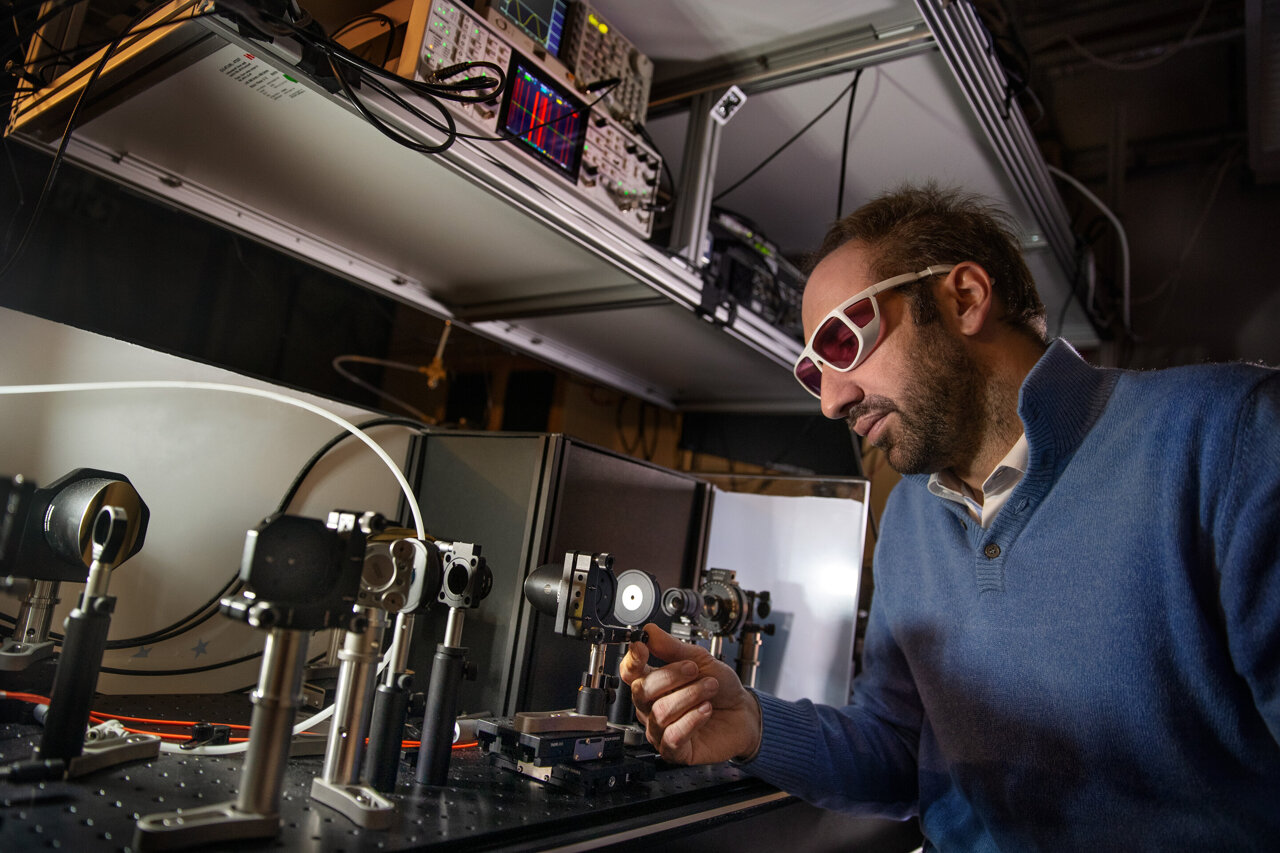
Stefano Bonetti in his lab at Stockholm University. Credit: Knut and Alice Wallenbergs Foundation/Magnus Bergström
The potential of quantum technology is huge but is today largely limited to the extremely cold environments of laboratories. Now, researchers from Stockholm University, the Nordic Institute for Theoretical Physics and the Ca’ Foscari University of Venice have succeeded in demonstrating for the very first time how laser light can induce quantum behavior at room temperature—and make non-magnetic materials magnetic. The breakthrough is expected to pave the way for faster and more energy-efficient computers, information transfer and data storage.
Within a few decades, the advancement of quantum technology is expected to revolutionize several of society’s most important areas and pave the way for completely new technological possibilities in communication and energy. Of particular interest for researchers in the field are the peculiar and bizarre properties of quantum particles—which deviate completely from the laws of classical physics and can make materials magnetic or superconducting.
By increasing the understanding of exactly how and why this type of quantum states arise, the goal is to be able to control and manipulate materials to obtain quantum mechanical properties.
So far, researchers have only been able to induce quantum behaviors, such as magnetism and superconductivity, at extremely cold temperatures. Therefore, the potential of quantum research is still limited to laboratory environments.
Now, a research team from Stockholm University and the Nordic Institute of Theoretical Physics (NORDITA) in Sweden, the University of Connecticut and the SLAC National Accelerator Laboratory in U.S., the National Institute for Materials Science in Tsukuba, Japan, the Elettra-Sincrotrone Trieste, the “Sapienza” University of Rome and the Ca’ Foscari University of Venice in Italy, is the first in the world to demonstrate in an experiment how laser light can induce magnetism in a non-magnetic material at room temperature.
In the study, published in Nature, the researchers subjected the quantum material strontium titanate to short but intense laser beams of a peculiar wavelength and polarization, to induced magnetism.
“The innovation in this method lies in the concept of letting light move atoms and electrons in this material in circular motion, so to generate currents that make it as magnetic as a refrigerator magnet. We have been able to do so by developing a new light source in the far-infrared with a polarization which has a ‘corkscrew’ shape,” says the research leader Stefano Bonetti at Stockholm University and at the Ca’ Foscari University of Venice.
“This is the first time we have been able to induce and clearly see how the material becomes magnetic at room temperature in an experiment. Furthermore, our approach allows to make magnetic materials out of many insulators, when magnets are typically made of metals. In the long run, this opens for completely new applications in society.”
The method is based on the theory of “dynamic multiferroicity,” which predicts that when titanium atoms are “stirred up” with circularly polarized light in an oxide based on titanium and strontium, a magnetic field will be formed. But it is only now that the theory can be confirmed in practice. The breakthrough is expected to have broad applications in several information technologies.
“This opens up for ultra-fast magnetic switches that can be used for faster information transfer and considerably better data storage, and for computers that are significantly faster and more energy-efficient,” says Alexander Balatsky, professor of physics at NORDITA.
In fact, the results of the team have already been reproduced in several other labs, and a publication in the same issue of Nature demonstrates that this approach can be used to write, and hence store, magnetic information. A new chapter in designing new materials using light has been opened.
More information: Stefano Bonetti, Terahertz electric-field-driven dynamical multiferroicity in SrTiO3, Nature (2024). DOI: 10.1038/s41586-024-07175-9. www.nature.com/articles/s41586-024-07175-9
Provided by Stockholm University
This story was originally published on Phys.org. Subscribe to our newsletter for the latest sci-tech news updates.
News Related-
Russian court extends detention of Wall Street Journal reporter Gershkovich until end of January
-
Russian court extends detention of Wall Street Journal reporter Evan Gershkovich, arrested on espionage charges
-
Israel's economy recovered from previous wars with Hamas, but this one might go longer, hit harder
-
Stock market today: Asian shares mixed ahead of US consumer confidence and price data
-
EXCLUSIVE: ‘Sister Wives' star Christine Brown says her kids' happy marriages inspired her leave Kody Brown
-
NBA fans roast Clippers for losing to Nuggets without Jokic, Murray, Gordon
-
Panthers-Senators brawl ends in 10-minute penalty for all players on ice
-
CNBC Daily Open: Is record Black Friday sales spike a false dawn?
-
Freed Israeli hostage describes deteriorating conditions while being held by Hamas
-
High stakes and glitz mark the vote in Paris for the 2030 World Expo host
-
Biden’s unworkable nursing rule will harm seniors
-
Jalen Hurts: We did what we needed to do when it mattered the most
-
LeBron James takes NBA all-time minutes lead in career-worst loss
-
Vikings' Kevin O'Connell to evaluate Josh Dobbs, path forward at QB
